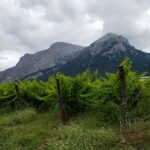
Many food lovers visit Naples in Italy’s Campania region to try the world-famous pizza. You even see people at the airport eating their first slices from large pizza boxes after you leave the arrival area! We came to taste the wines of Mount Vesuvius and to visit Pompeii, which on August 24, 79 AD was destroyed by a massive volcanic eruption that annihilated the entire city and its population.
Vesuvius is the largest active volcano region in Europe; it has been dormant since its last eruption in 1944. The demolished city of Pompeii is filled with vestiges of an ancient judicial court, palazzos of the rich, storefronts and taverns, and a brothel with phallic signage etched in stones to point the way. You’ll even seen ghost-like petrified human bodies and a dog; the agony of their last moments shows in their awkward contortions. It’s all worth a guided tour to point everything out and keep you from stumbling over the stones while navigating the ruins.
Pompeii may be ancient history, and Vesuvius may be dormant for now, but the vineyards around Vesuvius are vibrant and many are worth visiting, especially to try one of the region’s star wines, Lacryma Christi.
The Legend of Lacryma Christi
The origins of the name Lacryma Christi del Vesuvio (tears of Christ) vary depending on who you speak with. Some say when Jesus Christ first laid eyes on the Bay of Naples, He cried tears of joy over its beauty. Others say He cried tears of pain after Lucifer, Angel of Evil, was expelled from Paradise and stole a piece of Heaven to form the Bay of Naples. Some say He cried tears of relief because Lucifer was finally removed from Heaven and sent to Hell. Whatever version, the story ends the same: Christ’s sweet tears landed on the slopes of Mount Vesuvius and nourished the soil from which vineyards blossomed.

Lacryma Christi wines are a subzone in Vesuvio DOC (established in 1983). The dark, sandy volcanic soil is filled with fossils and minerals, including potassium and iron, lapidulli (little pebbles), organic matter and ash that have settled in from years of eruptions. This nutrient rich soil composition is immune to phylloxera, a common blight that affects vines. As a result, ninety percent of the local vines are ungrafted, meaning original rootstock, which is rare given that most vines today are grafted. The soil also contributes to the wines’ deep minerality
Indigenous white grapes cultivated include Falanghina, which is citrus-blossom fresh, and Coda di Volpe, a more full-bodied floral variety whose name means “tail of the fox,” a reference to the length and shape of the grape clusters. Caprettone, a white variety exclusive to the Vesuvius region usually used for blending. Aglianico is the Sophia Loren star of southern Italian red grapes, producing sultry wines that are full-bodied with great structure and long aging potential. Other reds include Piedirosso, a dark, earthy black-skinned grape whose name means “red feet,” and Olivella, named after its small olive-shaped grapes, which adds rustic, herbal notes.
DOC Guidelines for Lacryma Christi require that whites be made from a minimum of thirty-five percent and maximum eighty-five percent Coda di Volpe. The remaining twenty percent white grapes can be Falanghina or Greco Bianco. Red wines must be a minimum of fifty percent to maximum eighty percent Piedirosso; the remaining red grapes can be Olivella (up to thirty percent) or Aglianico (up to twenty percent) Both reds and whites should be consumed you and fresh.
Wine of the Pizza, Nectar of the Gods
Some refer to Lacryma Christi as “pizza wines,” probably since Naples is the home of the world’s most famous pizza, so it’s a natural pairing. Both the pizza and the wines were born on the slopes of Vesuvius. Historical records point to the first vines being planted on volcano slopes around 5th century BC.

Pizza Napoletana is made with San Marzano tomatoes also grown in the vicinity of the volcano, local Mozzarella di Bufala Campania, a tangy, supple cheese made with the milk of water buffalo so revered it has its own protected designation of origin (DOP); and fresh basil. The craft of making this pizza has been recognized by UNESCO as having “intangible culinary heritage.” Also on this list is the Mediterranean diet; so you can’t go wrong eating in Italy!
Local producers call Lacryma Christi “Nectar of the Gods.” When we visited a few producers, we felt their pride and a sense of place as we tasted the wines. Sommeliers in the U.S. have taken note as volcanic wines grow in popularity. There’s even an annual conference on volcanic wines every June in New York for the wine industry.
Christian Ferrulli, wine director at Cardonecello diVino in New York City said, “The whites have delightful tropical notes, nice acidity and minerality; I am finding many of them are better made now and extremely versatile, starting out as an apertivo to pair with dishes like our tuna tartare with avocado and lime. The sweetness of the avocado balances off the acidity of the white wine. As for the reds, Aglianico from Vesuvius has a smokier character than from other areas of Campania like Avellino. The tannins are deep and rich and complement the juiciness of our slow-braised Wagyu beef cheeks with cardoncelli mushrooms and our paccheri pasta with osso bucco ragout and bone marrow.” Cardonecello’s list currently carries Cantine Olivella Lacrima Nero 2016, a blend of Piedirosso, Olivella and Aglianico

Visiting the region, you can understand why one would be moved to tears. It’s both stunning and haunting. You think of the many lives lost to the wrath of Mother Nature and then you look around see just as much living beauty that She’s created. You drink it all in with a glass or two of Lacyrima Christi and sigh with content.
Visiting the Region
Many of the wineries are located to the south of the volcano in Vesuvius National Park. Appointments are necessary.
Three wineries to visit; all are family-run.
Bosco de Medici: The winery also has a stylish resort and restaurant. Where else can you find wines called Pompeii Rosso and Lavaflava?
Sorrentino Vini: This producer makes the only sparkling Lacryma Christi in the region called Bollicine.
Cantine del Vesuvio: The winery also offers cooking classes by appointment. It produces Lacryma Christi wines exclusively.
Wines to Try in the U.S.
Whites
Sorrentino Vini Lacyrima Christi Bianco Vesuvio DOC 2015 $17
Cantine Villa Dora Vigna Vulcano Lacryma Christi Bianco Vesuvio DOC 2016 $20
Cantina Olivella Lacyrma Christi de Vesuvio Lacrimabianco 2016 $15
Reds
Mastroberardino Lacryima Christi Rosso Vesuvio DOC 2017 $20
Terredora Dipaolo Lacryma Christi Rosso del Vesuvio DOC 2016 $21
Villa Dora Lacryma Christi del Vesuvio Rosso Gelsonero 2015 $21

Melanie Young co-hosts the national weekly radio show, The Connected Table LIVE! Wednesdays 2 pm EST on W4CY Radio and podcast permanently to iHeart.com and the free iHeart App.



